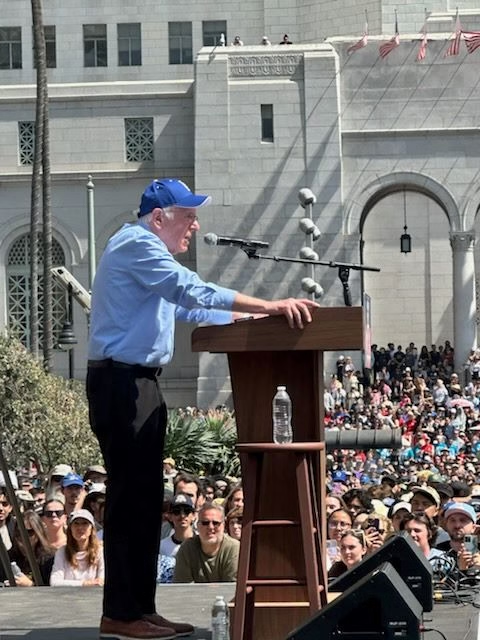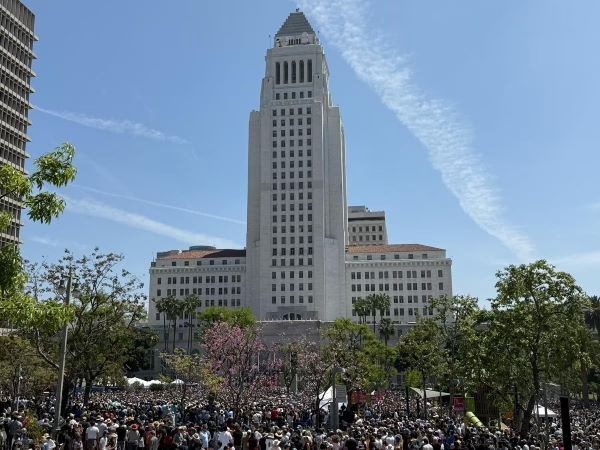Increased taxes are liberation
It takes a special kind of genius to take over a party whose main mantras were “All taxes are theft” and “No new taxes,” and convince them to put the yoke of one of the largest tax increases in American history on themselves.
To be able to transform that party into a crowd clapping and chanting “Increased taxes are liberation! Increased taxes are liberation! Viva la tariffs!” is not as much a stable genius as it is diabolical. I mean, increased taxes will set you free, right? That’s what he’s selling.
John Henrichs,
San Pedro
Game Over
Democrats who voted for Hillary Clinton, Joe Biden, and Kamala Harris have been tremendously disappointed. Consider also how Biden and Harris ran on the notion that a second Trump presidency imperils our country and democracy itself. This is ‘game over.’
So now what? James Carville says sit on our hands. Corey Booker disrupts Congress. Gavin Newsom has a podcast! Aside from that, we blew it. Life as we know it is forever changed. Democracy is the name of our great experiment no more.
Unfortunately, for our former bff’s such as NATO and the EU, it’s our frenemy, Putin, who’s won the affection of Donald Trump on behalf of the American people. And now this tariff strategy that’s supposedly designed to reclaim our manufacturing prowess appears more like Chinese checkers than the game of chess it was once conceived as.
Our new emperor seems to believe he’s rendered our adversaries panic-stricken, but it’s evident he’s played himself again. Trump has made himself ‘too big to fail’ just as he did back in the days of the Taj Mahal.
It all seems so inescapable. We could move to Canada! But there he is again, yammering about fifty-first statehood. I’m not sure why this brings to mind a tin star with a jerk pinned on, except to say that speaking of Musk, I can’t help but wonder if this isn’t all part of a plot devised subconsciously in the mind of an aggrieved billionaire. I’m as much a licensed psychiatrist as he is an elected official, so I don’t mind saying, “awkward.”
I wonder what’s more embarrassing. Elon Musk wielding that chainsaw, or all those first-time Republican voters who played “Who Wants to be a Millionaire?” Or maybe it’s most embarrassing that we’re having this Tesla revolt at all.
Justin Leach
San Pedro
Justin, What continues to amaze me is the number of people who, against all common sense, still believe the lies coming from the Orange Felon.
James Preston Allen, Publisher
Lost everything in the Eaton Fire
Unfortunately, I was one of the many who lost everything in the Eaton Fire in Altadena in January. I had rented a duplex bungalow for the past 11 years and the whole courtyard was destroyed. I have relocated to an apartment in Long Beach across the street from the Belmont Pier. Since I lived in Samoa in the South Pacific for two years as a kid, getting closer to the water and away from the fire devastation felt right (though, for now, I still commute a few days a week to my part-time job in Pasadena).
Hope all is well with you and RL. I just read your Feb. 20 editorial. I found the fires to be a great unifier in ways I would have not foreseen. You only need to go through one once to see how non-discriminatory fires are – they don’t care if you’re rich or poor, they’ll burn right on through. I am thankful that the community at large came together to help us. I am most grateful to the local groups of artists and musicians who have reached out and donated art supplies, music instruments, and I made sure to get in on FEMA while Biden was still in office as I knew a shitshow was on the horizon. Keep fighting the good fight.
Teresa Conboy
Long Beach
Middleton Update
This is actually old news but I haven’t had time to send out a message to all of you.
I was appointed to the Port of Los Angeles Board of Harbor Commissioners in 2019 by then Mayor Eric Garcetti. I served on the Board for over 5 years ending my term as Vice President of the Board. Late last summer Mayor Karen Bass declined to reappoint me.
I want to repeat the thanks I extended last year to all of you who supported me while I was on the Board. The Harbor community has meant the world to me. Being in the center of the largest port in the western hemisphere is quite the experience for all of us. I am particularly grateful for the support of the ILWU and the honor I received when I was made an Honorary Member of ILWU Local 13.
Despite no longer being a Board Member, I wasn’t ready to turn my back on this community! You have all taught me a lot and I value everything you have shared with me. Over the years I have developed a hope that the San Pedro Bay Port Complex (including the ports of both Long Beach and San Pedro) will not only remain and grow as a container port but will also become so much more. There are exciting developments on the horizon from the development of rail at Pier B in Long Beach to Alta Sea being the hub of the Blue Economy. The Goods Movement Training Center has the potential to not only continue skill development for the existing longshore workforce but open doors for community members who want to be part of the port economy. West Harbor is getting closer to opening day and Wilmington Park has finally given our Wilmington neighbors a window to the sea.
We are fortunate to have a Councilman who is simply the best! He is committed to the Port of LA continuing to grow and provide jobs but also to doing so in a thoughtful way that improves our health and the environment. Councilman McOsker asked me to join his office staff as his (unpaid) Senior Advisor for Port Affairs and I accepted.
Councilman McOsker has a great staff and you can always follow your usual channels to reach him but I wanted you to know you can also contact me to discuss anything that is port related. Contact me at diane.middleton@lacity.org. I am particularly interested in job development, environmental issues, and growing our union workforce.
Looking forward to making the One Five an even better place to live, work, and play.
Diane Middleton
Senior Advisor for Port Affairs 15th Council District | City of Los Angeles
North to Meet South at the Border
Bicycle Ride for Alex – through every port from Canada to Los Angeles
North is meeting South at an event only the ILWU can design. At the January Southern California Pensioners, Local 63 and 13 meetings, the Union’s fundraiser, ILWU Walk the Coast, revealed a bicycle ride. This is not a short outing on a lazy day or a sightseeing excursion. When the ILWU does something it is often big and unusual. In the name of the International Longshore and Warehouse Union, member Paul Zuanich has volunteered to take a challenging 1750-mile, 38-day electric bicycle journey to save children.
To kickstart his ride, Paul will meet some of our Canadian and Yankee brothers and sisters. Local 500 President Rino Voci and Secretary John Urrico have accepted Walk the Coast’s invitation to travel from their Vancouver, British Columbia headquarters on June 5th to gather with Paul and Local 7 President Bryson Tripp and some of his Bellingham members. Peace Park at the USA-Canada border will be the backdrop for this powwow and photo shoot. After North meets South to start the union ride of a lifetime, Paul will spin his pedals from Canada through Washington, Oregon and California. This challenge will take our rider and our ILWU message to Bellingham, Anacortes, Everett, Port Angeles, Port Gamble, Seattle, Tacoma, Olympia, Aberdeen, Astoria, Longview, Vancouver, Portland, Newport, North Bend, Eureka, Sacramento, Stockton, San Francisco, Port Hueneme and finally to the July 5th Southern California Bloody Thursday Memorial Picnic in San Pedro, California. Time and distance will cause Paul to miss only one beautiful port, Local 29’s San Diego.
The purpose of this great adventure is to do something good for others in need, unite every Division of the ILWU, and bring awareness to the good work our ILWU industry fundraiser is doing to support Alex’s Lemonade Stand Foundation. ALSF was founded by a beautiful four-year-old child, Alexandra Scott. Near her first birthday she was diagnosed with neuroblastoma, at that time an always fatal childhood disease. When Alex was in the hospital at age four, she announced to her mother that, after she left the hospital, she would hold a lemonade stand to raise money for other children. With her brother’s help, Alex raised $2000. Before her 2004 passing at age 8, Alex had raised over $1,000,000. Her mother, Liz, and dad, Jay, thought the effort ended. Alex was such an inspiration that people wouldn’t quit. The Foundation bearing her name has evolved into a fundraising movement. Today, ALSF is one of the leading funders of pediatric cancer research in the U.S. and Canada. They have raised more than $450 million, funding nearly 1,000 research projects at 150 institutions, and providing travel and support programs to families affected by childhood cancer.
No other union attempts anything like this fundraiser or this ride. As usual, the ILWU is unusual. Locals are free to meet Paul and give support in any way they choose. With the ILWU Credit Union’s help, invitation letters and information on how our members can assist Paul’s ride will be mailed to as many locals and groups as possible. ILWU Walk the Coast encourages longshore locals to connect with clerks, pensioners, auxiliaries, family, friends and, in ports where they operate, the Inland Boatmen’s Union. One thing every port can do to boost Paul’s ride is to take photos of each other with Paul. Email your photos to Local 63 Contract Administrator Robert Maynez, rmaynez@ilwu63.net. Photos will be posted on the ILWU Walk the Coast Facebook page and in The Dispatcher.
Companies have been very supportive, but a business is simply not built to do what our union can do. We have longtime friendships made and cultivated during committee meetings, caucuses and conventions. ILWU Walk the Coast is uniquely positioned to organize a fundraiser that joins ILWU Locals and Divisions from Canada, Alaska, Hawaii, Washington, Oregon and California, with pension groups, auxiliaries, industry companies, family and friends. This ride is a mission where everyone in our industry can meet and enjoy working together to do something good. The ILWU is proud to boast that our fundraiser is responsible for more than $1.3 million in total donations to Alex’s Lemonade Stand Foundation and the fight against childhood cancer. If you have any questions, please contact Robert Maynez or ILWU Credit Union VP Rob York, ryork@ilwucu.org. Every local that donates any amount will have their logo printed in The Dispatcher’s annual Thank You ad. If you don’t have a logo, Rob York will create one for you. A donation of any amount is appreciated and acknowledged. The amount of your donation is not the goal. Uniting for children is paramount. For more information, to donate or to see your local’s donation on the Donor Honor Roll, go to www.ilwuwalkthecoast.org. Paul’s ride schedule can be found online and will be printed in a future copy of The Dispatcher.
Dan Imbagliazzo
San Pedro
RE: Journalist/Activist response to Warren Furutani letter to editor March 20 edition
Warren Fututani is far too modest about his stature and effort to preserve and perpetuate the history of Terminal Island and the Japanese colony known as “Furusato.” Hear him reveal more in the oral history project Stories Of Los Angeles Harbor Area: For Yesterday, Today & Tomorrow (SOLAHA Volume I) available at website: www.storieslaharborarea.comwhere he relates his intrinsic connection and how his family was compromised under the Executive Order 9066 (February 19, 1942) by President Franklin Delano Roosevelt “reacting” to the bombing of Pearl Harbor December 7, 1941 by the nation of Japan, that caused the USA to finally and fully enter WWII. The indignity suffered by the residents and property owners has never been fully rectified, though his own mother in law who was relentless and legendary in her effort to achieve reparations as documented in the superior informing documentary Rebel With A Cause: The Life Of Aiko Herzig Yoshinaga (2016, 88 min., dir. Janice Tanaka) that has its Port of Los Angeles (POLA) premiere at the LA Harbor International Film Festival .
Over a decade ago Mr. Furutani and I met at the Los Angeles Maritime Museum (LAMM) “Caught, Canned and Eaten: The History of San Pedro’s Tuna & Canning Industry permanent exhibit (since 2007) and discussed the potential for museum to be located at Terminal Island (possibly in defunct SW Marine across from the Japanese Memorial) dedicated to the Japanese community and its venerable history. Subsequently LAMM created a permanent exhibit “Taminaru: A Day in a Life of a Japanese American Fishing Village” that is another testimony to documenting and preserving the venerable community. The Terminal Islanders also deserve much credit for their diligence and dedication. erecting the monument in Terminal Island and contributing to the exhibit.
In 2010 when Janice Hahn was Los Angeles City Councilwoman District 15 representing the harbor I was in conversation with her and the City of Los Angeles Office of Historic Preservation about how to propose a Motion in City Council about designation Fish Harbor with historic classification to protect its heritage. To my knowledge the Motion was not made, though it would need to be researched.
With regard to the POLA “demolition by neglect” is apt description of the lack of adhering to their pledge made May 28, 2013 in the Cultural Resource Policy that included among other (empty) promises: Establishing priorities for preservation and adaptive reuse, where possible, of historical buildings, structures, districts and other sites owned by or located on property owned by the Harbor Department. Staff will consider historical resources at the earliest stages of planning, adaptive reuse in leasing transactions will be encouraged. and most recently, in spite of much objection, the harbor commission decided to demolish the last (Starkist) tuna canning plant building in Fish Harbor. Our family legacy in the tuna canning industry is well known and we had long and valued relationships with the Japanese community who were friends and worked alongside my grandfather and father Joseph M. Mardesich, Sr. and Jr.
As I am often quoted, “If we do not save our history today, it’s gone tomorrow” and there are no better examples than “Beacon Street” and “Ports O’Call” – both gone with the sea. Current and future generations deserve better and thankfully there are some who valiantly strive to preserve and protect.
Cordially,
Stephanie Mardesich

























